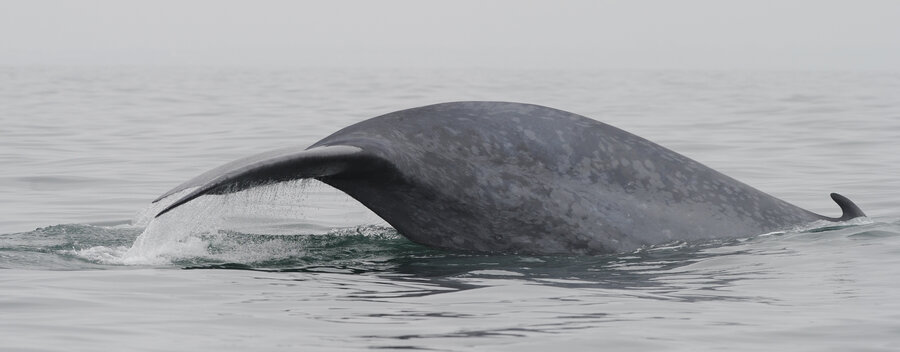How do blue whales get so humongous? Krill feeding study reveals clues.
Loading...
Despite being on record as the largest animal ever to have lived – even larger than the biggest dinosaur, the Argentinosaurus, which clocked in at 130 feet and weighed about 100 tons – blue whales eat something tiny: krill.
Blue whales can eat up to 4 tons of the shrimp-like creatures in a day. As you may have learned in science class or at a museum trip, the massive creatures take in a mouthful of sea water and krill, then force the water out through their filtering baleen with their tongues, which can weigh as much as an elephant.
Or maybe it's not quite that simple, suggests a new paper in the latest issue of Science Magazine.
"For blue whales, one of our main questions has been: 'How do they eat efficiently to support that massive body size?' " asked Elliott Hazen, a NOAA ecologist, in a press release. "Now we know that optimizing their feeding behavior is another specialization that makes the most of the food available."
Former studies suggested that blue whales simply open their mouths and pull krill in when they are hungry. But according to a new study in the latest issue of Science Magazine, their feeding behavior is more nuanced.
Dr. Hazen and his colleagues hypothesized that baleen whales, like large terrestrial mammals, must be efficient bulk foragers.
Blue whales and their baleen whale cousins are known to use "bubble netting," a technique in which the whales, sometimes swimming in teams, will dive below a krill swarm, sending up an enormous fountain of bubbles to alarm and displace the group. The disoriented krill are then much easier to catch.
Using digital acoustic recording tags for 55 blue whales off the coast of California, the researchers discovered another tool in the blue whale’s hunting toolbox.
Up to 2 million krill can swarm together, but not all krill patches are equally dense – and the whales are paying attention. When feeding on a low-density krill patch, blue whales will lunge fewer times per dive, to save oxygen, found the researchers.
By examining both the maximum number of lunges taken per dive, and the krill density within each area, the scientists calculated that blue whales successfully optimize both energy and oxygen to yield the most efficient results.
In effect, the enormous mammals have two different feeding modes: conserving energy when prey is scarce and using up more oxygen to dive deep and take in large amounts of prey when krill are abundant.
The whales' feeding modes may relate to their migration patterns, but that needs further research. Some whales stay in one place year-round – like the pods living in the warm, krill-rich waters off Southern California – while others migrate seasonally.
Globally, blue whales are classified as endangered. According to the IUCN Red List, the world oceans now house between 10,000 and 25,000 blue whales, which is about 5 percent as many blue whales as lived before the whaling industry brought them to the brink of extinction. Thanks to whaling bans, their numbers are slowly rebounding.








